Scan this on your smartphone to watch Steve Morgan and Garry Fitzgerald test the Avenger 488.
QR2
Scan this to watch Garry Fitzgerald do a walk through of the Avenger 488.
There’s no denying it – the Sea Jay Avenger 488 is one big tinny. Derived from the ever popular Avenger range from Sea Jay, this locally built aluminium boat is sure to turn heads at most boat ramps across the country. If not for its pretty wrap, then just for its sheer size. It’s deep and it’s wide.
Especially compared to the nuggety Garry Fitzgerald, who met me at the Raby Bay boat ramp for the morning’s test run.
Of course, being a week day, conditions were glassy – totally inappropriate for boat testing. However, we still managed to get out and have some fun over a couple of hours on the water, and highlight some of the things this boat does well.
The first of these is economy. Ridiculous economy. Doing the performance runs in southern Moreton Bay, the Suzuki gauge touched 4km per litre of fuel burned. Great figures for a boat touching 5m in length.
The second was stability. The 2.3m beam is not only apparent in the Avenger’s cavernous cockpit, it’s evident while moving around on the water. Sure, reversed chines help a little, but it’s just the massive width that makes this such a stable platform on the water.
At the waterline, the Sea Jay carries less beam to the bow, resulting in a narrower, wave-cutting entry. I thought that this might make the boat less stable, but I couldn’t notice the difference. Unfortunately, the billiard-table-like Moreton Bay didn’t provide conditions to see if the sharp bow rake did what it looked like it would do. It looks like it would cut the water better than your run-of-the-mill tinny.
Fitzy said one of the attractions of the Avenger is its practical simplicity.
“Sea Jay likes to keep things simple,” he said, “and the rear livewell is as simple as they come.”
With no powered pumps and water draining straight through to the outside through strategically placed holes in the hull and transom, it’s a classic design that’ll never let you down.
And that design theme continues throughout this boat.
The side console is simple and functional. Electronics need to be bracket mounted on top of the console behind the windscreen, but there is a handy little covered box for your valuables (keys, wallets and mobiles). Otherwise, the design is minimalist.
Fitzy is also a big fan of the Sea Jay system of seat mounts.
“I’ve had Sea Jay boats for nearly 20 years and I’ve always loved this seat mounting system,” he said.
“There’s nothing protruding up from the deck, so if you’re packing something on top of a seat mounting position, it sits flush.”
Indeed, Sea Jay’s seat bases are built in house and look strong enough to ski from!
Up front, there’s an ample casting deck for those who like throwing plastics at predators, but Sea Jay has also mounted the Minn Kota battery up front, too. Distributing the weight like this pushes the bow down and makes the bow rake do what it’s supposed to do, and that’s cut water.
The test model was supplied on a special Sea Jay trailer that’s been custom made by Dunbier trailers. Featuring a C-section frame, it’s designed to not hold any saltwater, thereby eliminating any points where corrosion can gain a foothold. It’s something I’ve seen previously in imported trailers but I have rarely seen it locally in galvanised steel. There are plenty of alloy I-beam trailers made in Australia.
Priced in the high $20,000s for a basic package and in the low $30,000s for one kitted out like the test model, the Avenger is cheap for a boat of this size and most definitely cheap to run. You can get more information at your local Sea Jay dealer or by visiting www.seajayboats.com.au.
• Quoted performance figures have been supplied by the writer in good faith. Performance of individual boat/motor/trailer packages may differ due to variations in engine installations, propellers, hull configurations, options, hull loading and trailer specifications.
Facts
SPECIFICATIONS
| Hull thickness | 3mm |
|---|---|
| Gunwale thickness | 3mm |
| Beam | 2.3m |
| Depth | 1.22m |
| Floor ribs | 12 |
| Capacity | 5 persons |
| Hull weight | 435kg |
| Rec hp | 70hp |
| Max hp | 90hp |
| Max motor weight | 175kg |
Facts
PERFORMANCE*
| RPM | km/L |
|---|---|
| Idle | 4.2 |
| 1000 | 5.2 |
| 2000 | 3.7 |
| 3000 | 3.5 |
| 3700 | 4.0 |
| 4000 | 3.7 |
| 5000 | 2.7 |
| 5500 (WOT) | 2.4 |
*Fitted with a 17” pitch propeller

Depending on options, a Sea Jay Avenger package like this will set you back somewhere in high twenties to low thirties. And then it’ll give you 4km/L fuel economy.

Wow – a place specifically designed to hold keys and mobile phones. I doubt it’s completely waterproof but it is splashproof.
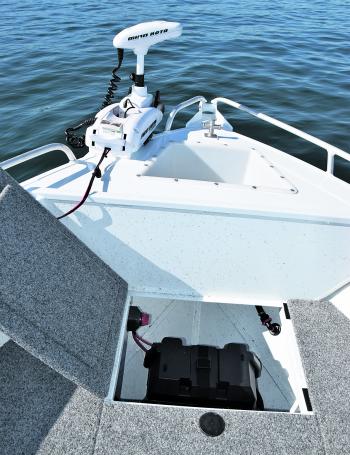
It’s not rocket science to build a boat with traditional and virtual anchoring systems to work side-by side.
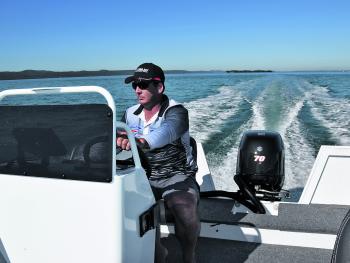
As usual, here’s a calm weekday for boat testing. Yes, the weekend following it was windy. Typical.
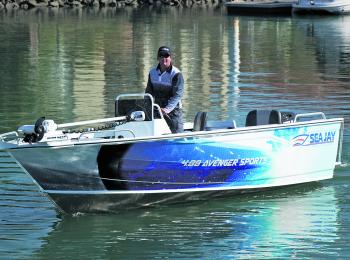
Adding to the existing Avenger range, the 488 boasts massive beam and depth. The factory-installed wrap adds a touch of class.
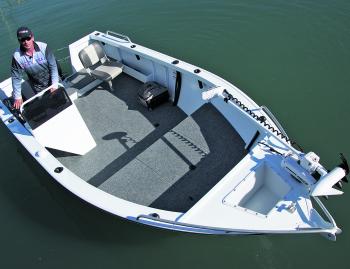
Now THERE’S a mountain of deck to work with. Huge casting decks and a beamy cockpit mean that this boat opens up plenty of options – no matter where in Australia you’re fishing.
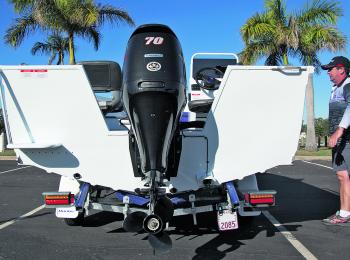
This is not trick photography, but Garry Fitzgerald is fairly height challenged and the 488 is an incredibly beamy boat with high gunwales.
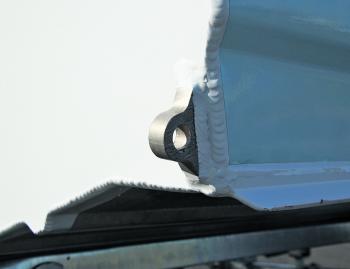
Sometimes it’s the little things that make all the difference. Realising that a tie-down strap isn’t the best solution for most boats, these little tie-downs let you use a short strap to the trailer, minimising damage and straps humming down the highway.

The side console is simple and effective. Bracket mounting the sounder is the best option.
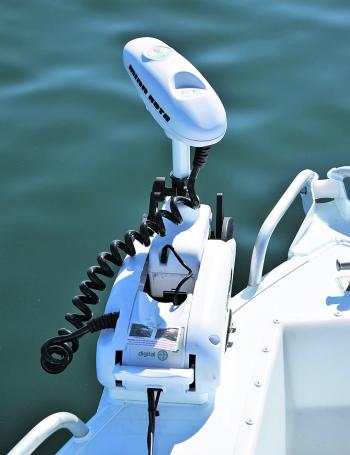
Not many boats of this ilk leave a dealership without a bow-mounted electric motor nowadays. The test Sea Jay sported a Minn Kota model with a for’ard mounted battery to balance the ride.

Side pocket storage is simple – just like the build. Big, beamy and simple means trouble-free boating.
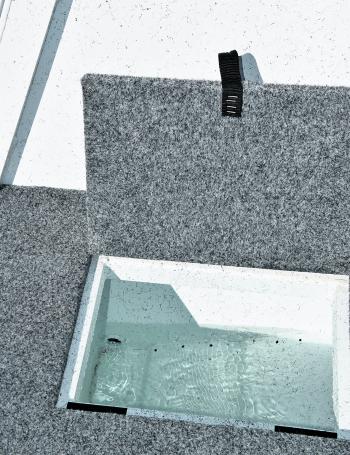
This self-filling and draining livewell has no plumbing apart from a bung and holes to fill and maintain a level. No pumps to burn out and no pipes to burst here.




